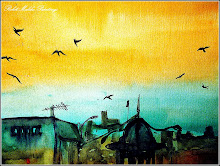A New Phase of Matter
Between 1850 and 1888, researchers in different fields such as chemistry, biology, medicine and physics found that several materials behaved strangely at temperatures near their melting points. It was observed that the optical properties of these materials changed discontinously with increasing temperatures. W. Heintz, for example, reported in 1850 that stearin melted from a solid to a cloudy liquid at 52°C, changed at 58°C to an opaque and at 62.5°C to a clear liquid. Others reported observing blue colors when compounds synthesized from cholesterol were cooled. Biologists observed anisotropic optical behavior in "liquid" biological materials, a behavior usually expected only in the crystal phase.
An important invention of the time was the heating state microscope by Otto Lehmann, a physicist from Karlsruhe, Germany. This microscope allowed control of the temperature of the sample. In a later version, with polarizers added, it became the standard equipment in every liquid crystal research laboratory.
In 1888, an Austrian botanist named Friedrich Reinitzer, interested in the biological function of cholesterol in plants, was looking at the melting behaviour of an organic substance related to cholesterol. (The chemical structure of cholesterol was still unknown. Today we know that the observed substance was cholesteryl benzoate). He observed, as W. Heintz did with stearin 38 years before, that the substance melted to a cloudy liquid at 145.5°C and became a clear liquid at 178.5°C. He repeated an earlier observation which showed that upon cooling the clear liquid, a brief appearance of blue color could be seen at the transition temperature, and that a blue violet color appeared just before crystallization. Discussion with Lehmann and others led to the identification of a new phase of matter called the liquid crystal phase.
Foundations
Research in the area of liquid crystals burgeoned in the years after 1888. Some of the more important results are listed below.
The claim that a new phase of matter was found was challenged by important scientists like Walter Nernst and Gustav Tamman. They argued that the phenomena could be explained as an effect of an emulsion of two distinct phases or compounds. Further experiments by Lehmann and others supported his theory. Later theoretical work by Emil Bose also gave rise to arguments against the hypothesis of an emulsion.
Max Born suggested a theoretical description of liquid crystals as molecules with permanent electric dipoles. This theory unfortunately leads to faulty results.
In 1922 in Paris, France, Georges Freidel suggested the classification scheme which is used today with different phases of liquid crystals called nematic, smectic and cholesteric.
Carl Oseen in Sweden worked on elastic properties of liquid crystals and his results were used on the continuum theory by England's F.C. Frank. This theory is one of the basic theories to describe liquid crystals today.
The Order Parameter S was introduced to describe the order of liquid crystals.
Alfred Saupe, a German physicist, later working at Kent State University, worked together with his advisor Wilhelm Maier in Karlsruhe 1958 on his thesis ("Diplomarbeit"), a molecular theory of liquid crystals not involving permanent dipoles as Max Born's theory did. This work gave rise to the Maier-Saupe Theory, another well-known basic theory of liquid crystals.
Silence
From 1945 to 1958 all was quiet on the liquid crystal front. People thought they knew everything about liquid crystals and that nothing new could be expected in this area. Even worse, they were not even included in textbooks. An entire decade of growing scientists did not have contact with liquid crystals. No one could yet imagine how large a role liquid crystals would play in technical applications today.
In 1958 Glenn Brown, an American chemist, published an article in Chemical Reviews on the liquid crystal phase and subsequently sparked an international resurgence in liquid crystal research.
Future of Liquid Crystals
The future of liquid crystals has just begun. There are still unsolved physical problems in this area, despite the fact that researchers in the fifties had already withdrawn form this area, thus giving an interesting field for the pure scientist. The need for liquid crystal applications grew, requiring engineers specialized in this field. Statistics show that cathode ray tube displays in TVs and computer monitors will be overtaken by liquid crystal displays in the near future. More recent applications involve switchable windows that can be changed from clear and opaque with the flip of a switch, liquid crystal displays with wider viewing angles, and displays that can remain in use for years without the need of power.
Knowledge in the field of liquid crystalls is crucial for an understanding of biological membranes, thus biologists, medical researchers and pharmacists are also interested in liquid crystal research.
Conclusion
A strange form of matter which piqued the curiosity of scientists at the end of the last century has grown into an enormous industry with a great variety of applications and is still growing. This is an important field of research for scientists of many different disciplines: engineers, physicists, chemists, biologists, medical researchers and pharmacists.




